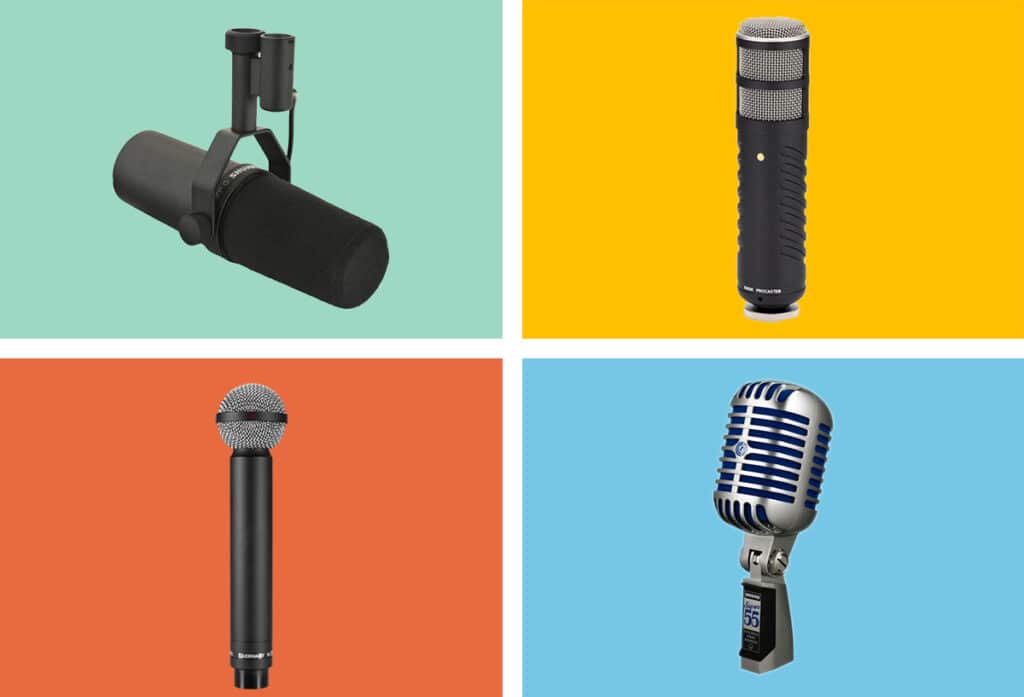You hear the term "dynamic" very often in audio, but here the term has a different meaning. In the case of the dynamic microphone, it refers to a physical phenomenon that takes place inside the microphone - a form of electromagnetism that also takes place in a bicycle dynamo: When an electrical conductor moves in a magnetic field, an electric current is induced.
This principle makes it possible to convert sound waves into electromagnetic waves so that they can either be reproduced amplified via loudspeakers (live performance) or recorded.
Tip: If you are looking for a microphone for recording vocals in the studio, I recommend my article on the best vocal microphones.
Dynamic microphone or condenser microphone - What is the difference?
The dynamic microphone is more robust than the condenser microphone, but it has a lower frequency response. This means that very high frequencies are cut off, but that's not necessarily a bad thing. It all depends on how you want to use it.
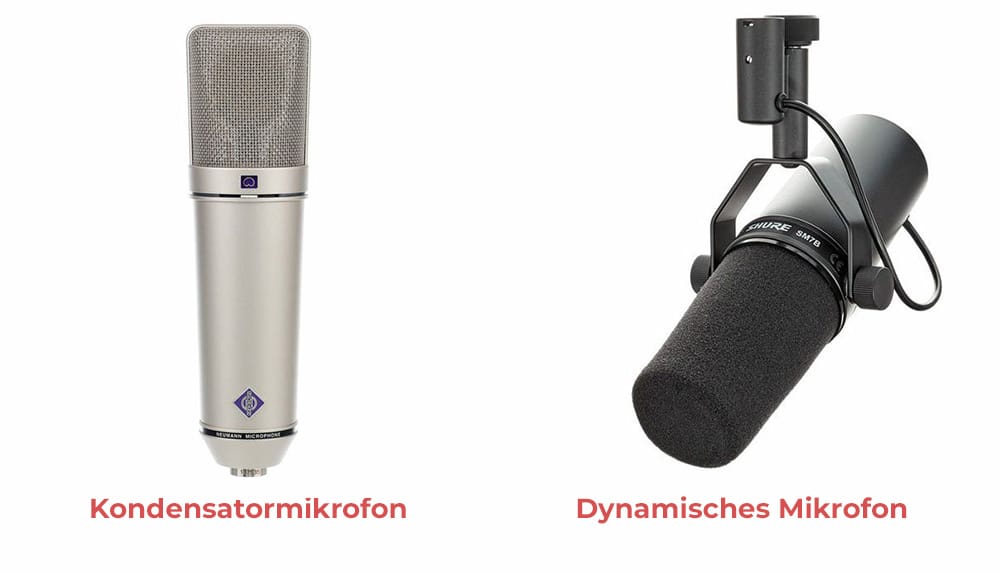
In addition, dynamic microphones do not require an external power supply and are generally less expensive than condenser microphones. Condenser microphones require 48V phantom power, which any modern audio interface or mixing console has.
Condenser microphones tend to sound much more spatial than dynamic microphones - that is, you hear more of the sound reflections in the room. So you need good acoustics in the room to make decent recordings with a Rode NT1A or Neumann U87, for example.
That's why dynamic microphones are usually the first choice for home studio producers who don't have good acoustics. For this, the Shure SM7B is the best choice, as it delivers good sound even in untreated rooms.
Applications of dynamic microphones
Dynamic microphones are used primarily in live applications, but also in the studio for particularly loud situations, such as recording drums. Depending on the instrument being amplified, their characteristics and applications vary greatly.
Their design features make them suitable for high sound pressures, so they can handle the particularly high volumes that can occur on a stage.
They do not require phantom power and are powered directly via the XLR cable. That is why they are practical and preferred in live situations.
There are basically two types of dynamic microphones: ribbon microphones and moving-coil microphones.
Also interesting: The best microphones for kids
Moving-coil microphones (often simply referred to as dynamic microphones)
Moving-coil microphones are basically constructed in the same way as a speaker, but have the exact opposite function. The diaphragm is permanently connected to a magnetic coil, which is "immersed" in a static permanent magnetic field by the movement of the diaphragm.
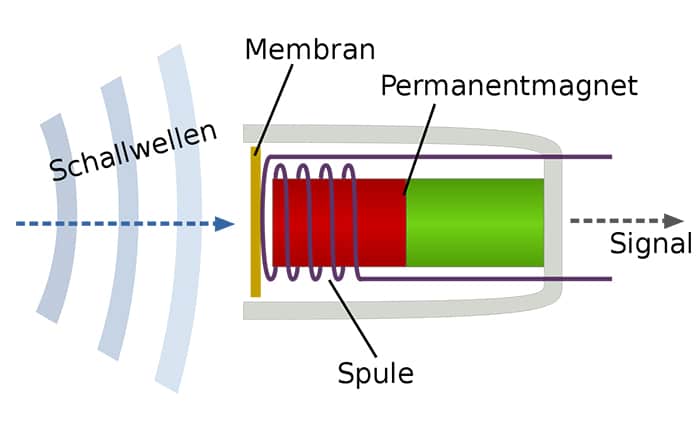
The relative movement from the coil into the magnetic field generates a voltage that is proportional to the speed of the membrane. Thus, the sound can be converted into an electrical signal voltage.
Advantages: These microphones are very robust and can withstand high sound pressure levels, so they are always the first choice for the stage. And the simple design makes them much cheaper than ribbon microphones.
Disadvantages: Because the sound wave has to move the diaphragm and coil and thus do work, these microphones have a lower sensitivity. For this reason, the finest details cannot be captured sometimes. However, this can sometimes be desirable as they provide a "dirtier" sound.
Ribbon microphones
➔ Read more about ribbon microphones here
In the ribbon microphone, the diaphragm is a small aluminium strip 2 to 4 mm wide, bent in a zigzag and a few centimetres long. Depending on the design, one or two of these membranes are built between the poles of a magnet in a way that they oscillate back and forth a little when an incoming sound wave hits.
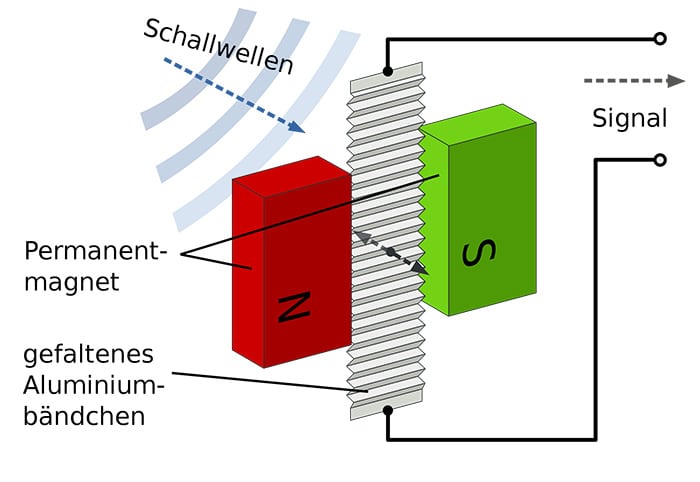
This movement within the magnetic field generates - just as with the moving coil microphone - a signal voltage that is proportional to the speed of sound. Voilà, once again sound waves are converted into electrical voltage, which is exactly the purpose of a microphone.
In addition, an amplifier is always built into these microphones, which amplifies this very low induced voltage by a factor of 30.
Advantages: These microphones offer a very linear and wide frequency response. They are very transparent and true to the original. The sound is very detailed compared to the moving coil microphones - even the smallest nuances are picked up.
Disadvantages: These microphones are extremely sensitive and therefore not suitable for the stage. They are also treated with special care in the studio! They are also much more expensive than the moving coil microphones.
What are the most important aspects to consider when choosing the best dynamic microphone for your applications?
First of all, it is important to know that each model has certain characteristics and a different frequency curve. Therefore, it is important to know what the purpose is and what we want to do with the microphone. You need a completely different dynamic microphone for recording a bass drum than for a singer!
Each model can then have cuts or boosts at certain frequencies. The AKG D112, for example, is designed to record deep, bass-heavy instruments. If you record female vocals with this microphone, they usually sound very bad.
And it sounds just as bad when I record the bass drum of a drum kit with a Shure SM 57 (which is actually meant for snare and guitars) - in 99% of the cases you won't like the sound. That's why it's always very important to do thorough research before buying a dynamic microphone and to know the areas of application.
If we need a dynamic microphone for a solo singer that has to last many evenings and for a long time, the ergonomics and weight of the microphone certainly play an important role. A lighter and handier model will tire the artist less.
When we look for a microphone for choral work, it is important to control the pattern and direction of the incoming sound. This ensures that the sound coming in from different directions is picked up at a 360° or 180° angle, without favouring one direction over another.
As you can see, there are a lot of things to consider before buying. We have selected and compared the best dynamic microphones here to make your choice easier.
Best dynamic microphones
1. Electrovoice RE-20: The best professional dynamic microphone
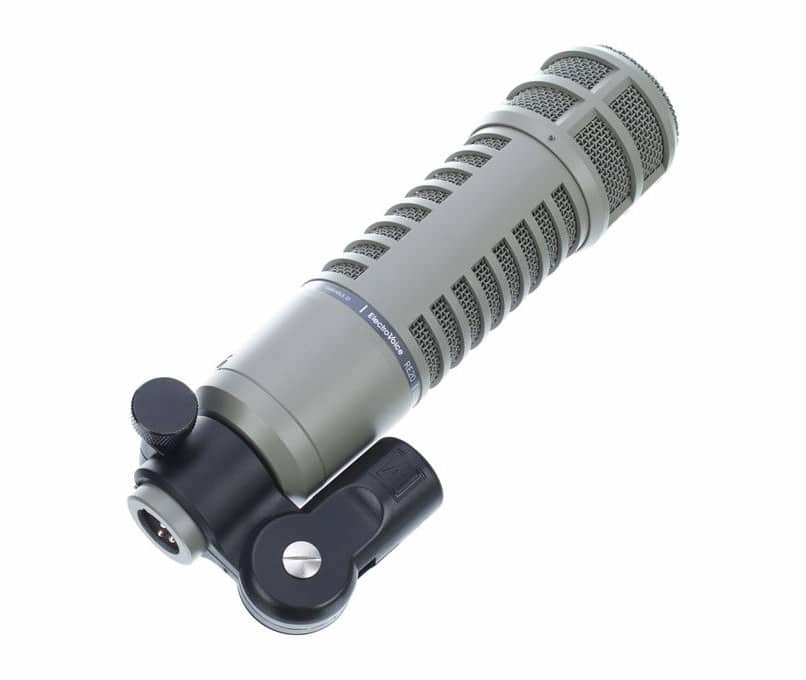
The Electrovoice RE-20 is one of the best professional dynamic microphones on the market, used primarily for live sessions, but also performing excellently in the studio.
The cardioid polar pattern is suitable for miking live instruments where you need to pick up the signal from the front of the microphone and exclude all others. The solid and superbly crafted materials guarantee a long service life and are perfect for frequent use in a variety of situations.
The frequency response is flat with no particular cut or boost, which means that this dynamic microphone delivers an authentic, realistic and unaltered sound, giving the sound engineer maximum scope for modification.
The noise level is extremely low due to the choice of components, so you can record "quieter" instruments and voices with this microphone without hearing a lot of noise.
This microphone is great for vocals, bass drum and brass, and is also a popular choice for podcast recording. You'll find at least one RE-20 in every professional recording studio! The construction is very rugged - it's almost impossible to break this microphone.
If you are looking for the best professional dynamic microphone for miking your instruments during live performances, I recommend the Electrovoice RE-20. I use it myself in my studio for all kinds of things.
In my opinion, this dynamic microphone is worth every euro!
Key Advantages
- Really good audio quality
- Sturdy hardware
- Incredible detail and impulse fidelity
Downsides
- Expensive compared to other models
Price: 598€, Link: Thomann
2. Shure SM7B: The legend among dynamic microphones
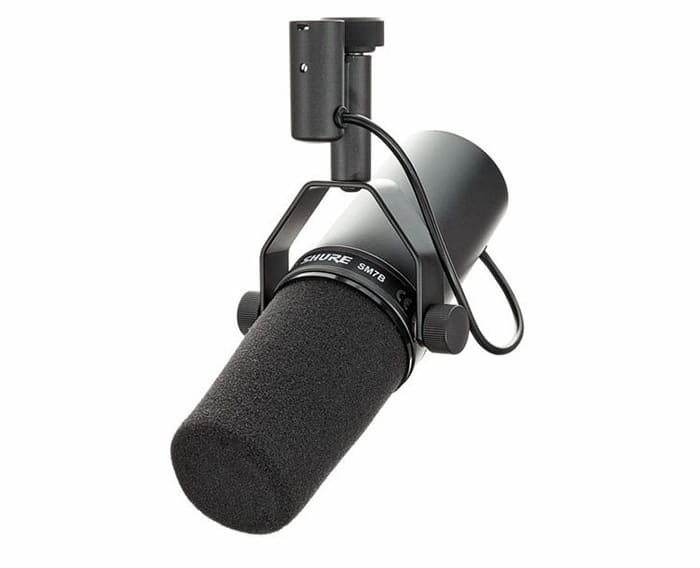
The Shure SM7B is, in my opinion, the best dynamic microphone for vocalists. It has a truly professional sound that is more reminiscent of condenser mics. It's full, warm and enveloping - just what you need to make the best vocal recordings and capture the audience's attention in live performances.
This dynamic microphone was made famous by Michael Jackson, among others - it was used by his producer Quincy Jones and his recording engineer Bruce Swedien for almost all tracks of the album "Thriller" for Michael Jackson's vocals.
The Shure SM7B is a unidirectional cardioid dynamic microphone that amplifies forward-facing audio sources and attenuates off-axis sources to the maximum.
Besides vocals, this microphone is suitable for many instruments, such as electric guitars, acoustic guitars, snare, wind instruments, strings.... As you can see, this microphone is really versatile!
The frequency response is wide, so it covers the entire audible spectrum and even more - accordingly, the sound is very present and "airy". Rolled-off bass frequencies and a slight emphasis on the midrange - both of which you can turn on and off with a switch - make for a more energetic and present sound.
It is shielded against hum & noises and has broadband interference protection to prevent this interference from being heard or even recorded. The internal pneumatic anti-shock system prevents the transmission of mechanical noise. Because of these features, this dynamic microphone is very popular among podcasters.
If you want to learn more, be sure to check out the article where I explain why the Shure SM7B is so legendary.
Key Advantages
- Very suitable for vocal recordings, especially for female vocals
- Little interference and room noise
- Very good price for the sound quality
Downsides
- Nothing, in my opinion this microphone is a must-have for every recording studio
Price: 379€, Link: Thomann
3. Beyerdynamic M 160
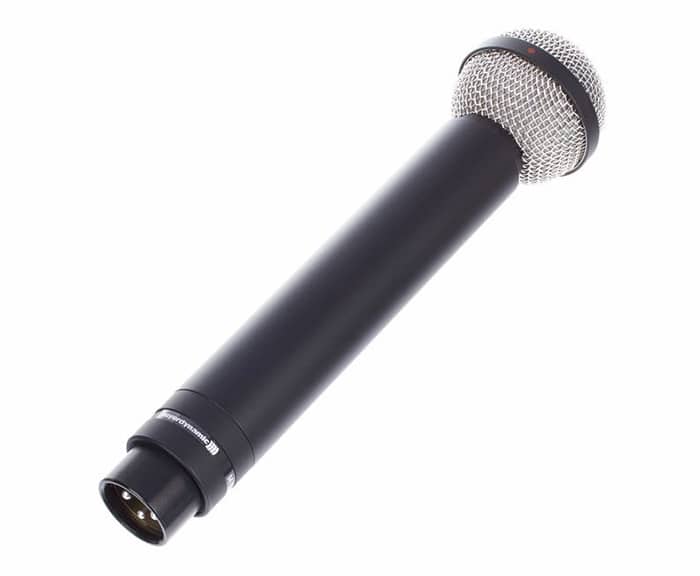
The Beyerdynamic M160 is a high-end dynamic ribbon microphone that stands out for its practicality, ergonomics, design and sound quality. Beyerdynamic is undoubtedly one of the leading microphone manufacturers, and the M160 fully confirms the brand's reputation.
This dynamic microphone is legendary and was used for various purposes: David Bowie used it as a vocal mic and Led Zeppelin used it as a drum mic for a special sound on "When The Levee Breaks".
As you can see, the Beyerdynamic M160 is very versatile - but it's particularly useful for guitar, drums, wind instruments and singers.
The frequency response is indeed very wide: from 40 Hz to 18,000 Hz, reproducing a warm, full and natural sound, making the voice even more pleasant to listen to. The technology and polar pattern is a single dual-band diaphragm with hypercardioid polar pattern, resulting in less interference from ambient noise when recording in the studio.
The attenuation is 25 db at 110 °. It is suitable for both live and studio applications, but live you have to treat it with special care, because it is not as rubust as for example an SM58 from Shure. The weight is only 156 g, and the dimensions are 156 x 23 x 38 mm.
If you are a fan of the characteristic Beyerdynamic sound and are looking for a good dynamic microphone, the M 160 is a recommendable choice.
Key Advantages
- Very good and detailed sound
- Also suitable for live performances due to the hypercardioid polar pattern
Downsides
- Price
Price: 659€, Link: Thomann
4. Shure Super 55 - The classic
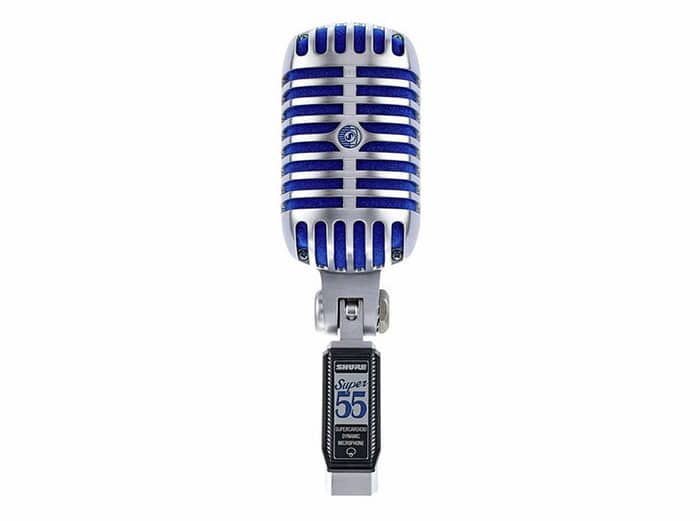
The Shure Super 55 is a dynamic microphone characterised by its vintage design, one of the main reasons why it is so popular and appreciated. The sound and performance are high-end and allow you to sing live with a sound performance that is truly remarkable.
This dynamic microphone is the successor and modern brother of the Shure 55SH, a microphone closely associated with Elvis Presley. He used it very often, which can be seen in many historical pictures.
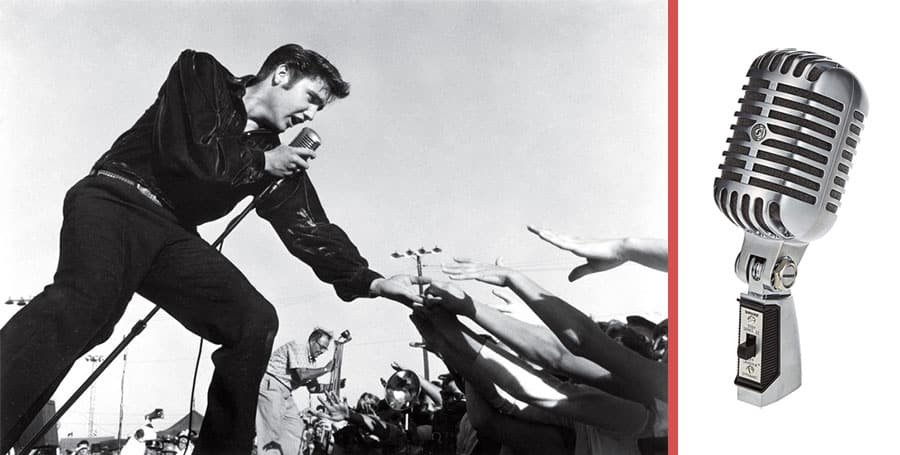
The Shure Super 55 combines the classic vintage sound and look of its predecessor with modern features that make this dynamic microphone an excellent choice.
The design is chrome-plated and the touch of blue gives it even more elegance and character. The polar pattern is supercardioid, which is ideal for live situations. The frequency response is perfect for amplifying vocals to sound natural and realistic. It is reminiscent of the vintage sound that defined an era - the specified frequency range is between 60 and 17,000 Hz.
One of the best features for on-stage use is the high gain: before feedback is triggered, high gain levels can be managed, giving the voice considerable input volume and making the final sound full-bodied.
The anti-shock microphone capsule minimises noise caused by handling and general movements to which the microphone may be subjected. The robust and solid metal construction ensures maximum reliability in any situation.
If you're looking for a good live mic and you're a fan of vintage design and sound, the Shure Super 55 is a recommended choice. And it looks really good on stage, in my opinion!
Key Advantages
- Great vintage sound, always good for rock'n'roll
- Very good EQ curve for vocals
Downsides
- Unfortunately no more on/off switch
- Not suitable for every genre
Price: 249€, Link: Thomann
5. Shure Beta 52A: The best dynamic microphone for bass drums
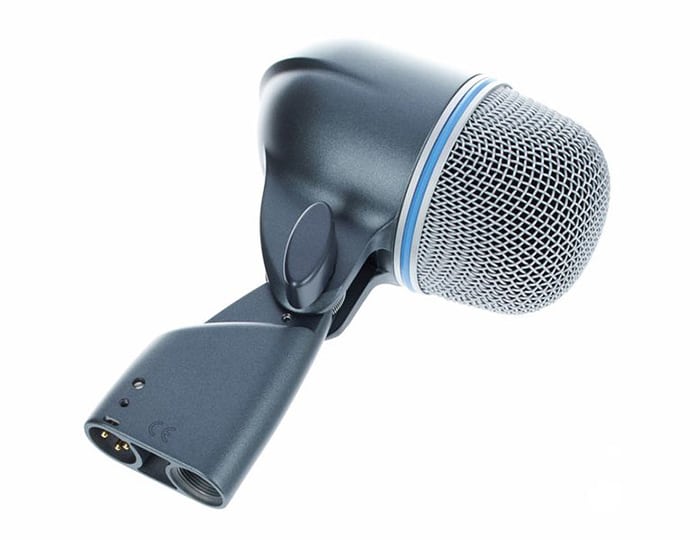
The Shure Beta 52A is one of the best dynamic microphones for amplifying or recording low-frequency instruments, and the best one for recording kick drums. The optimized design as well as the frequency response are optimal and allow a wide use of this product, with professional results.
Although it is priced in the mid-range, the Beta 52A's performance can easily be placed in a higher category. The polar pattern is supercardioid, which gives this microphone high feedback immunity. This is exactly why it is usually the choice for bass drum miking in live situations.
But this dynamic microphone is also very often used for studio recordings, because the sound is excellent. I often use it myself for bass drum recordings together with a large-diaphragm condenser microphone like the Neumann U87 or Rode NT1A.
Since it can withstand high sound pressure levels, it is the perfect dynamic microphone for instruments such as bass guitar or bass drum, and generally for anyone playing in the lower frequency range. The high gain before feedback allows you to record very loud instruments without noise or distortion.
The careful construction and the grid made of hardened steel make the microphone very resistant to wear and tear and unwanted impacts. The pneumatic isolation system minimises the mechanical noise caused by moving your hand and gripping the microphone. Just hold it and move - the construction technology does the rest.
Key Advantages
- Bass drums sound good through this microphone in 99% of the cases
- Great for live applications thanks to the supercardioid polar pattern
Downsides
- Limited application possibilities - but it does what it is supposed to do, and does it excellently
Price: 188€, Link: Thomann
6. Rode Procaster: Microphone for speakers with best price-performance ratio
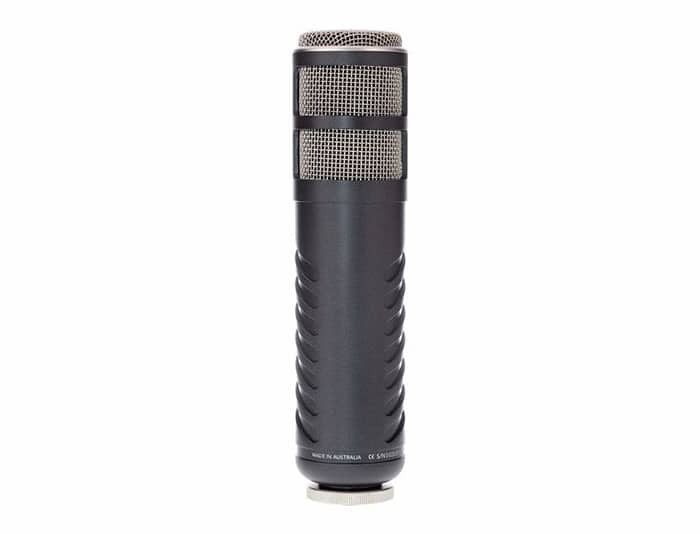
The Rode Procaster is a professional dynamic microphone with unidirectional polar pattern and special features for broadcasting applications at an excellent price-performance ratio. For a truly unique price, you'll take home a powerful, professional microphone that will raise the level of your voiceover or vocal recordings to the next level.
This is a microphone with a frequency response of 75 Hz to 18 kHz. The cardioid pattern is unidirectional and very narrow, so it picks up and amplifies the frequencies of the voice in front of the microphone, while all others are drastically attenuated. It is therefore also perfect for radio situations with several speaking people, where the voices of one must not penetrate the microphone of the other.
The weight is 745 grams, but the ergonomics allow for smart and easy positioning. It is made entirely of metal, which makes it robust and resistant to wear and time. That's why it's a product you can use every day without giving it much thought.
The dynamic high-performance capsule provides a full-bodied, powerful, clear and authentic sound. The design is retro-inspired, which gives it an extra touch of class and elegance. So in the case of video podcasts, it helps the aesthetics of the broadcast.
So if you're a podcaster looking for the best and most affordable Rode mic for these applications, we recommend the Rode Procaster.
Key Advantages
- Unbeatable price-performance ratio
- Perfect for voice-over artists and podcasters
- Ergonomics
Downsides
- Requires lots of gain
Price: 179€, Link: Thomann
7. Shure Beta58 A - The best dynamic microphone for live vocals
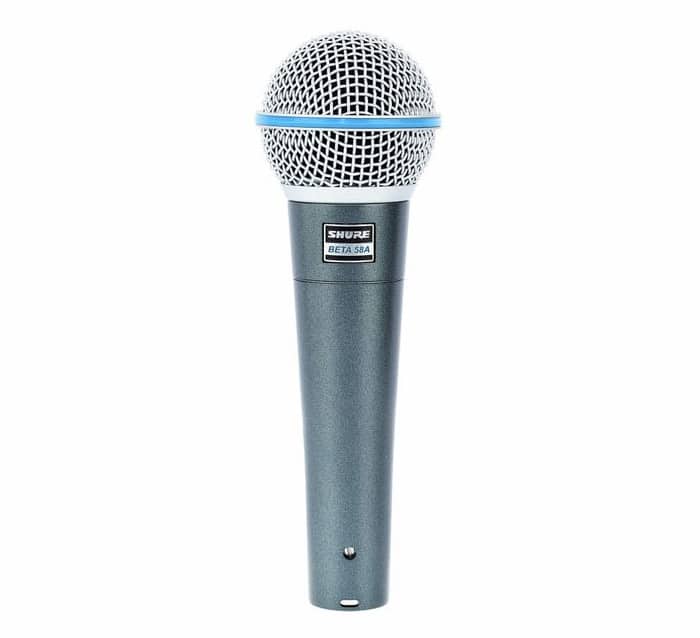
The Shure Beta58 A is one of the most popular live dynamic microphones for singers around the world. The construction technique and hardware are designed to amplify these frequencies and make the vocal characteristics even more pronounced.
As a supercardioid dynamic microphone, it offers excellent sound quality that reproduces vocals cleanly and clearly. By cutting the low frequencies, the proximity effect is drastically reduced, bringing out the mid and high frequencies even better.
It can tolerate high gain, which is why it can be used on stages to amplify the voices of singers and increase the gain as needed without causing feedback. The use of the neodymium magnet ensures an output with a great signal-to-noise ratio.
The construction materials are very solid, making this microphone perfect for intensive use. The hardened steel grille protects against unwanted shock and wear. The advanced pneumatic anti-shock isolation drastically reduces mechanical noise and vibration caused by movement and handling.
So if you need a microphone that enhances and complements your brilliant voice, the Shure Beta58A is the best dynamic microphone you can find in this regard. There is a reason why it can be seen on almost every stage around the world!
Key Advantages
- Vocal always cuts well in the mix
- Good audio quality
- Sturdy hardware
Downsides
- There are better microphones for studio use
Price: 175€, Link: Thomann
8. Sennheiser E835S: The best dynamic budget microphone from Sennheiser
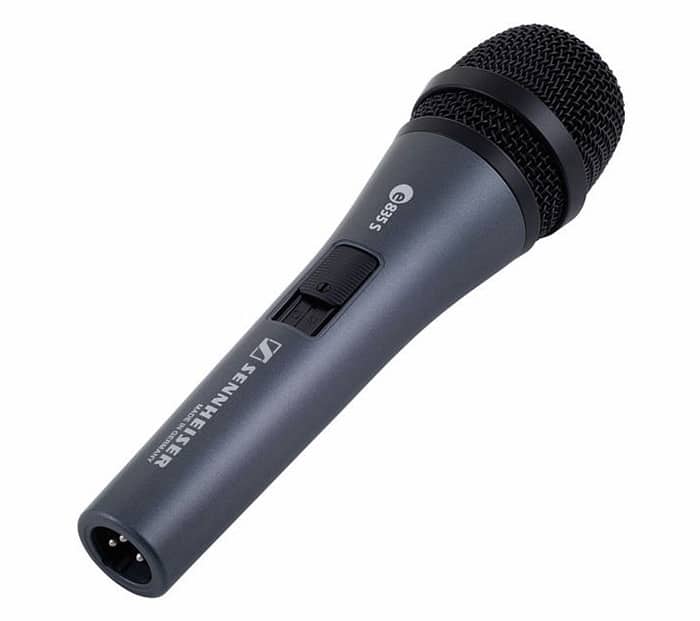
The Sennheiser E835S is the inexpensive dynamic microphone we recommend as an initial purchase for those who do not have professional requirements. It is indeed an excellent dynamic microphone for live singing or amateur recordings. Price and performance make a very attractive combination.
The high output level enables the reproduction of a powerful and present sound and reduces feedback effects. The construction materials, the housing and the metal grille make it resistant and thus durable. It is equipped with an on/off switch to mute it at any time. Very practical for singers.
The frequency response, which ranges from 40 to 16000 Hz, is balanced and linear, amplifying vocals on axis and eliminating ambient noise. Included with the microphone is a carrying case for storage during transport or when not in use, and a mount that allows you to adjust it to your preferred position.
If you have higher standards, you should check out its bigger brother, the Sennheiser E945. This one delivers slightly better quality and has a supercardioid pickup pattern, making it an even better live vocal mic.
Key Advantages
- Very good price-performance ratio
- On and off switch
Downsides
- Very sensitive to air blasts ("plosives" like P, T, K...), therefore the use of a pop filter is recommended.
Price: 89€, Link: Thomann
9. Shure SM58 - The world's best-selling dynamic microphone
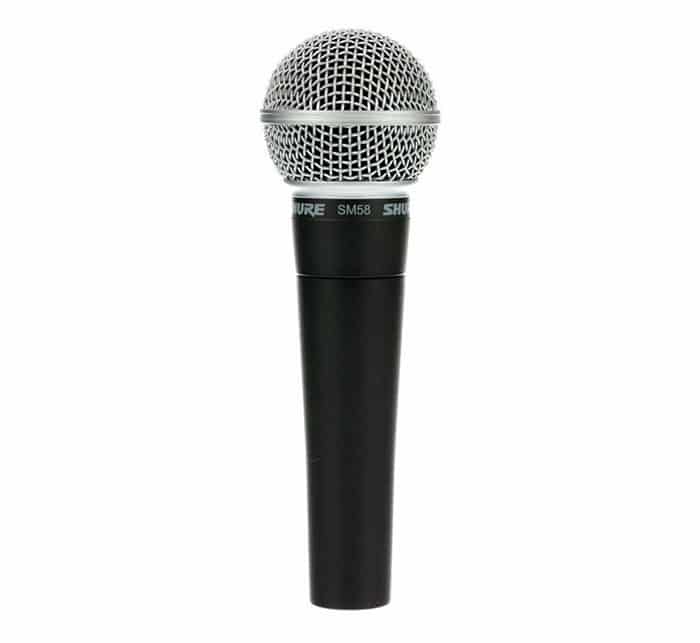
The Shure SM58 LC is the best-selling and most used dynamic microphone in the world. Professional, high quality, reliable, durable and lightweight, it has been found for years on stages and studios all over the world, in professional and non-professional situations.
This model has a unidirectional cardioid polar pattern: on stage, it amplifies the sound source directed frontally at the microphone and attenuates everything else. This way, sound from other instruments or monitors does not reenter and feedback problems are not caused.
It is precisely from this point of view that it is one of the microphones preferred by stage sound engineers, as it can withstand high sound pressures, handle high gain instruments without causing feedback, even when the complexity of the instruments and the interlocking frequencies vary.
The frequency response ranges from 15 to 15kHz and is boosted around 4000 Hz, making it a dynamic microphone specifically for vocals and thus offering a present, warm and bright timbre. By lowering the lower frequencies, problems with proximity effect are avoided.
I myself always place this microphone next to my Neumann U87Ai when recording vocals and sometimes the vocals sound even better (or rather more "fitting" to the song) through this microphone than through the Neumann, which costs 25 times as much!
The pneumatic isolation system minimises mechanical noise that would be caused by the hand holding the microphone. Hold it in your hand and move freely - the design technology does the rest.
So if you're looking for the best Shure microphone with the best value for money, don't hesitate to choose the Shure SM58. You'll understand why, after all these years, it's still the most widely used microphone in the world.
Here you can find the full article about this microphone.
Key Advantages
- Very good value for the money
- Very good sound quality
- Very versatile - can be used for guitars, amplifiers, winds, strings and drums in addition to vocals
Downsides
- Nothing, this dynamic microphone is an absolute knockout
Price: 92€, Link: Thomann
10. Shure SM57 - The universal microphone for instruments
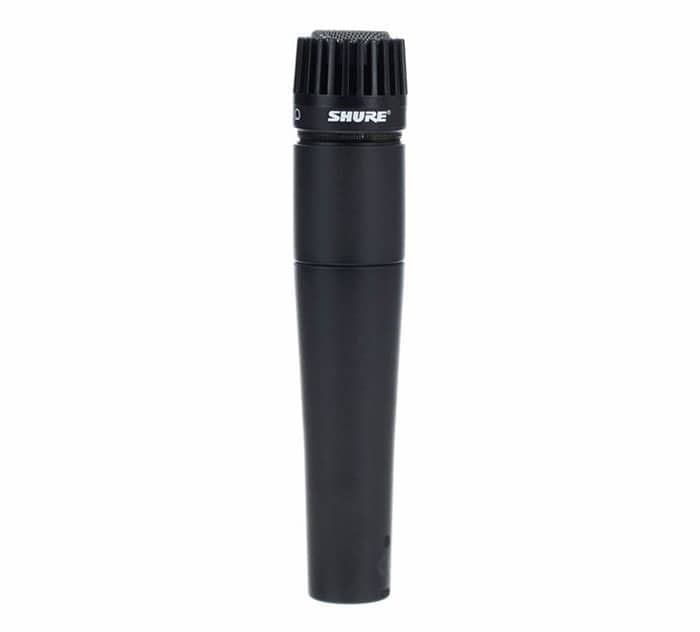
Another global standard, the Shure SM57 is known for offering quality and professionalism at an affordable price. It is one of the most versatile dynamic stage and studio microphones for miking drums, acoustic guitars and guitar amps. I have three of these in my studio.
The microphone capsule is the same as the SM58 - so the sound is actually identical - but the SM58 has a built-in pop filter, which the SM57 does not. Due to the capsule design, the SM57 has a slight boost at 5 - 7 kHz. The Shure SM58 does not have this.
It's a cardioid model, which makes it perfect for live and studio recording where you need to amplify and record what's coming from the musical instrument on axis with the mic, to the exclusion of everything else.
The frequency response is wide, allowing this dynamic microphone to be used for a variety of applications such as drums, percussion, amplifiers, guitars and even bass and vocals. The reproduced sound is authentic, realistic and well balanced, giving the sound engineer plenty of freedom both on stage and in the studio.
It has a pneumatic anti-shock isolation system that drastically reduces driving noise. The construction materials are solid and robust, so it is truly durable and therefore suitable for long and frequent use where bumps and falls may occur.
If you're looking for an affordable, professional and versatile instrument microphone with confidence in the brand, you're on the safe side with the Shure SM57.
Key Advantages
- Very good value for the money
- Very good sound quality
- Very versatile - can be used for guitars, amplifiers, winds, strings and drums in addition to vocals
Downsides
- Not necessarily suitable for vocals - although I have used it myself with pop filter
Price: 84€, Link: Thomann
11. AKG D5 - The most affordable dynamic microphone
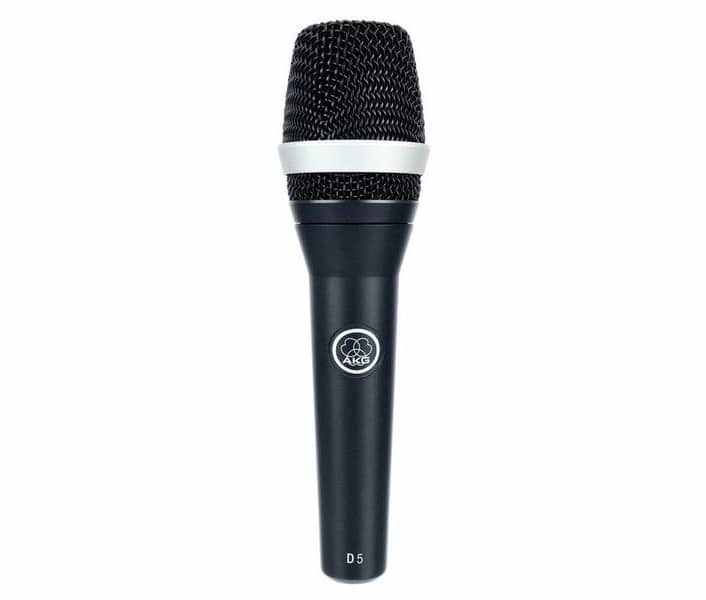
The AKG D5 is the best budget dynamic microphone for singers, whose performance, price and features are sure to satisfy you.
The AKG D5 is the model we recommend for those who want to buy a dynamic microphone and spend as little as possible. If you don't have professional requirements, but just want to sing or podcast/stream, you will have a lot of fun with this model.
First of all, it offers a very wide frequency response for an entry-level model, ranging from 70 Hz to 20000 Hz. This allows the entire audible frequency spectrum to be covered, resulting in a balanced and linear voice. The supercardioid pickup movement is perfect for eliminating feedback and returns.
A built-in anti-pop filter is also included: Whether you use it for recording sung vocals or for speaking, it reduces the effect of harsher consonants, making the sound softer and more pleasant.
The boom adapter makes it ready for tripod use, while the dual-shock capsule prevents manipulation noise from being too audible and thus interfering with playback/recording. The sensitivity is 2.6 mV/Pa.
Key Advantages
- Wide frequency band
- Integrated pop filter
Downsides
- EQ not always balanced
Price: 79€, Link: Thomann





